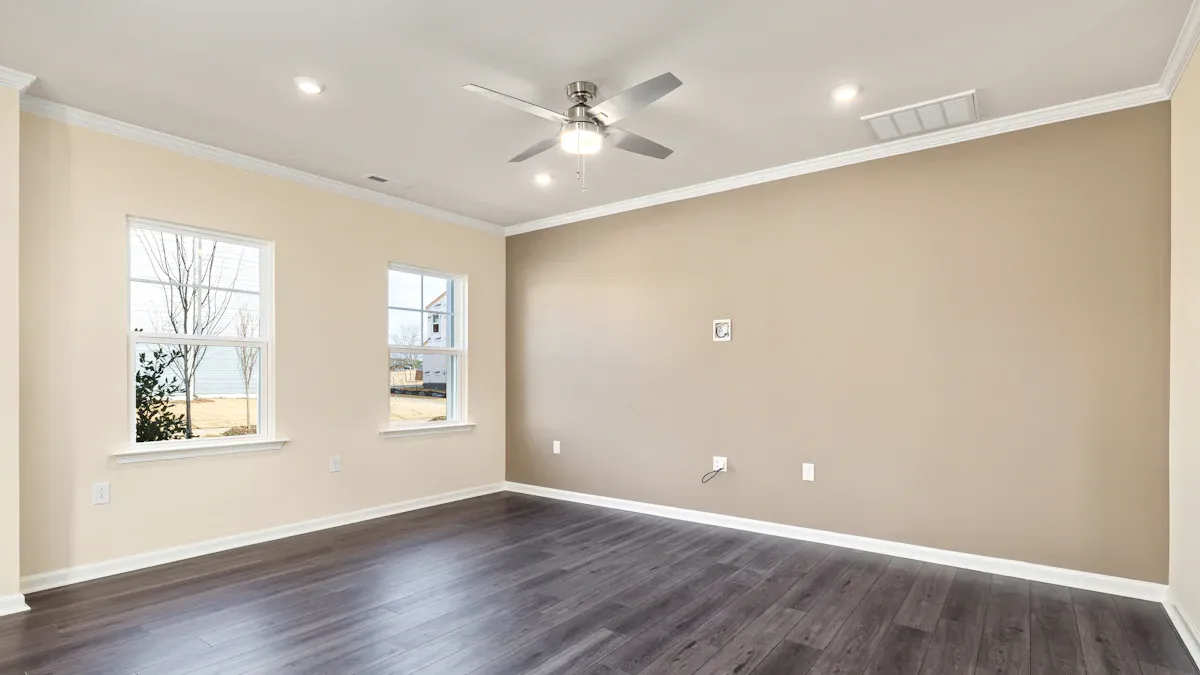
I always try to find ways to lower my electricity bill. This is very important in summer when I use fans more. I looked at different fan choices. I saw that Brushless DC (BLDC) ceiling fans use much less energy than regular fans. The table below shows how they are different:
|
Fan Type |
Energy Consumption Reduction |
Electricity Bill Savings |
|---|---|---|
|
BLDC Ceiling Fans |
Up to 60% savings |
|
|
Traditional Fans |
Standard consumption |
Higher bills |
If I change to BLDC fans, I can use 60% less power. I can also save up to $38 every month. Knowing these facts helps me make good choices for my home.
Key Takeaways
-
BLDC ceiling fans use 65% less power than regular fans. This helps you save a lot on your electricity bills.
-
If you switch to BLDC fans, you can save up to $38 each month. This makes them a good choice for saving money over time.
-
BLDC fans are quiet and last longer. This means you spend less on fixing them. They also make your room more comfortable.
-
Smart features like remote control and automation make things easier. You can change the settings from anywhere in the room.
-
Picking energy-efficient fans saves you money. It also helps the planet by lowering your carbon footprint.
Energy Savings Overview
Quick Comparison
When I looked at different fans, I saw they use different amounts of energy. BLDC ceiling fans use much less power than regular ceiling fans. BLDC fans need only 28 to 35 watts when running fast. Traditional fans use about 70 to 80 watts or even more. This means BLDC fans help me save electricity every month.
Here is a table that shows how much power each fan uses:
|
Fan Type |
Power Consumption (Watts) |
|---|---|
|
BLDC Ceiling Fan |
28-35 |
|
Traditional Fan |
75-90 |
I checked how much energy these fans use in a month. BLDC fans use about 8 to 10 units. Traditional fans use 28 to 32 units. This is a big difference for my electricity bill.
|
Fan Type |
Monthly Units Consumed (approx.) |
|---|---|
|
Traditional Ceiling Fan |
28-32 |
|
BLDC Fan |
8-10 |
-
BLDC fans use much less power than regular fans.
-
This helps save a lot of money on electricity bills.
Why It Matters
I want to save money and use less energy. Fans that use less power help me spend less on bills. Using less energy stops me from wasting electricity, especially when fans run in empty rooms. I learned that using fans wisely helps me live better.
Tip: Turn off fans when you leave a room to save more energy.
Saving energy with BLDC ceiling fans lowers my bills. It also helps the planet by using less energy. Every small change I make helps over time. I feel proud to make smart choices for my home and future.
Brushless DC (BLDC) Ceiling Fans
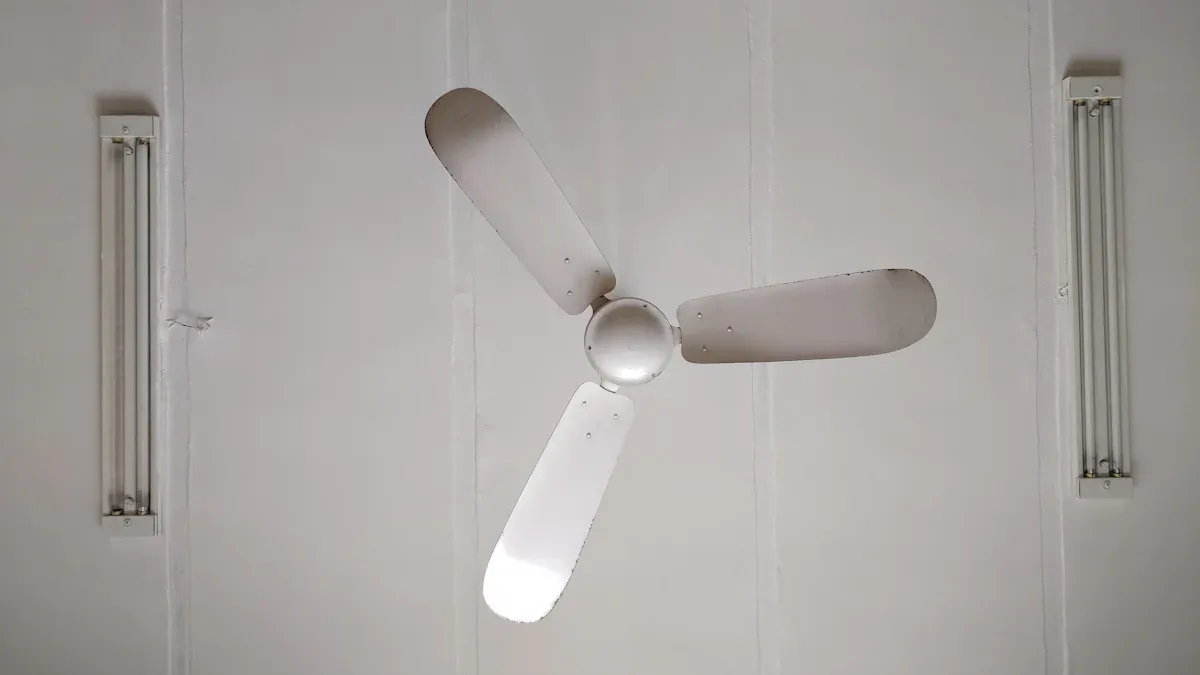
How BLDC Fans Work
I learned that Brushless DC (BLDC) ceiling fans use a special motor that does not have brushes. This design helps the fan run smoothly and quietly. The motor uses ActivBLDC technology, which lets the fan create the same airflow as regular fans but with much less energy. I noticed that these fans have a better power factor, so they use electricity more efficiently.
BLDC ceiling fans give me more control over speed settings. I can choose the exact speed I want, which helps me avoid wasting energy. Many models also come with smart features. For example, I can set timers or use sleep modes. These options help me use the fan only when I need it, saving even more electricity.
Note: BLDC fans are eco-friendly because they use less power and help lower my carbon footprint.
Here are some benefits I found with Brushless DC (BLDC) ceiling fans:
-
They offer precise speed control.
-
Many models include smart features like timers and sleep modes.
-
They run quietly and last longer.
Sinox BLDC Fan Efficiency
When I looked at Sinox BLDC fans, I saw that their models use only 28 watts. This is much lower than regular induction-based fans, which often use 75 watts. I checked how this affects my yearly electricity costs. The difference surprised me.
|
Type of fan |
Average Wattage |
Yearly Cost |
|---|---|---|
|
Induction based fan |
75 watts |
Rs. 2463.75 |
|
BLDC fan (Sinox) |
28 watts |
Rs. 919.8 |
I realized that switching to Sinox BLDC ceiling fans could save me a lot of money every year. The lower wattage means I spend less on electricity. I also help the environment by using less energy. Sinox fans give me strong airflow while keeping my bills low.
I now understand why so many people choose Brushless DC (BLDC) ceiling fans for their homes. These fans offer great performance, smart features, and real savings.
Traditional Ceiling Fans
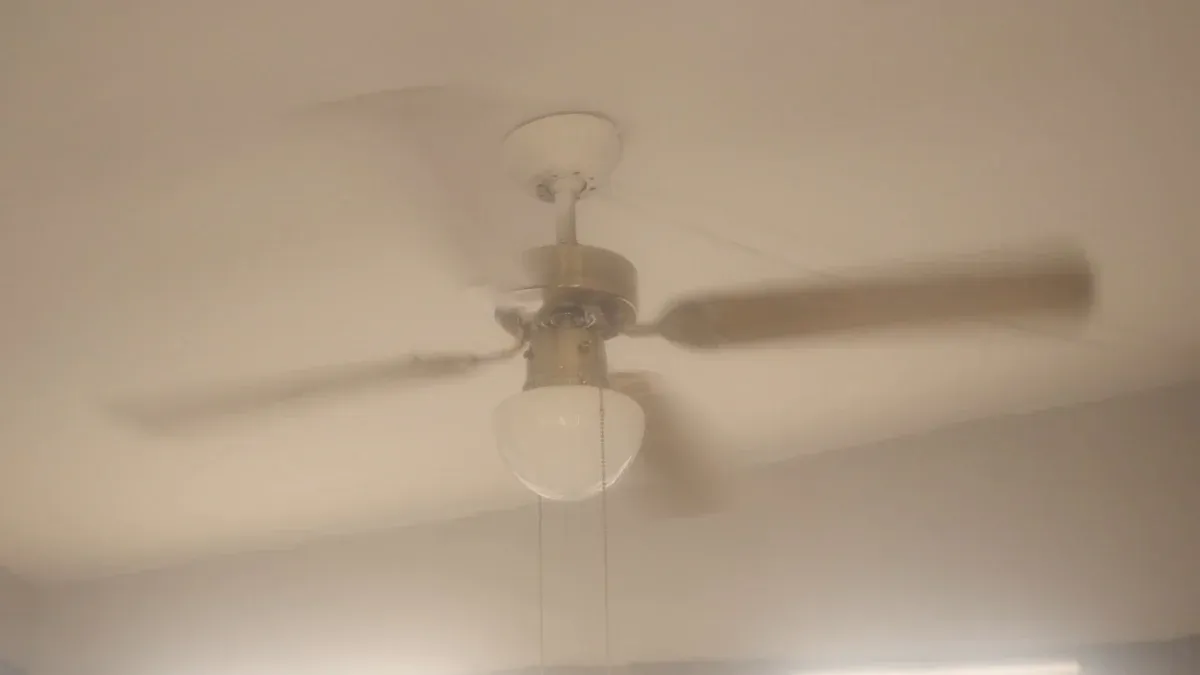
How Traditional Fans Work
I have used traditional ceiling fans in my home for many years. These fans use an AC induction motor to spin the blades and move air around the room. The motor relies on carbon brushes and metal parts that create friction when running. This friction causes the fan to use more energy and makes it noisier than newer models.
I notice that traditional fans often make a humming sound, especially at higher speeds. The moving parts inside the motor can wear out over time, which means I sometimes need to replace or repair them. The design is simple, but it does not focus on saving energy.
Here is a table that shows how traditional ceiling fans compare to BLDC fans:
|
Feature |
Traditional Ceiling Fans |
BLDC Fans |
|---|---|---|
|
Motor Type |
AC Induction Motor |
Brushless DC Motor |
|
Energy Efficiency |
Lower due to friction |
Higher, up to 65% less power |
|
Noise Level |
Higher due to carbon brushes |
Minimal due to zero friction |
|
Mechanical Wear |
More due to carbon brushes |
Less due to electronic control |
Tip: Regular cleaning and maintenance can help traditional fans last longer and run more smoothly.
Power Consumption
I always check how much electricity my fans use. Traditional ceiling fans usually consume more power than BLDC fans. Most standard 52-inch ceiling fans use between 60 to 70 watts at medium speed. Some models can use as little as 10 watts, but others go up to 120 watts, especially if they have built-in lights.
Here are some common power consumption ranges for traditional ceiling fans:
-
A standard 52-inch fan uses 60 to 70 watts at moderate speed.
-
Maximum speed can use up to 75 watts.
-
Fans with lights may use 50 to 120 watts.
-
Smaller fans, like 30-inch models, use about 42 watts.
I found a chart that shows how much power different fan sizes use:
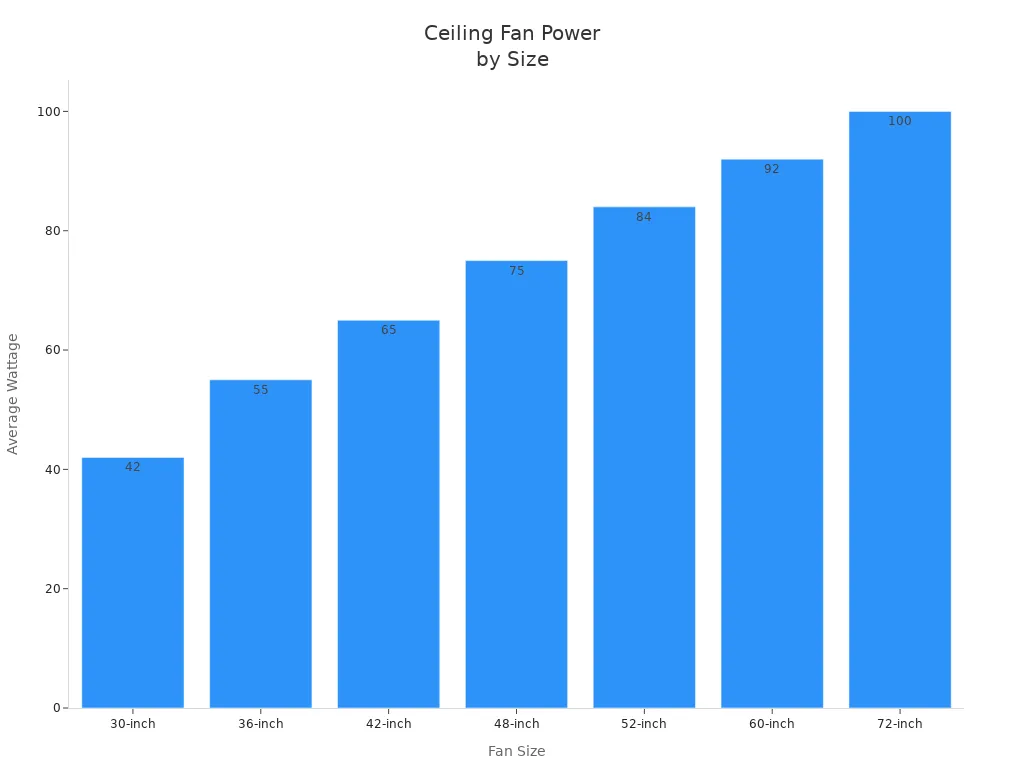
Here is a table with average wattage for different fan sizes:
|
Fan Size |
Average Wattage |
|---|---|
|
30-inch |
42 watts |
|
36-inch |
55 watts |
|
42-inch |
65 watts |
|
48-inch |
75 watts |
|
52-inch |
84 watts |
|
60-inch |
92 watts |
|
72-inch |
100 watts |
I see that most traditional fans use between 50 to 75 watts. Some energy-efficient models use less, but regular fans still use more power than BLDC fans. This means my electricity bill is higher when I use traditional ceiling fans for long hours.
Power Usage
BLDC vs. Traditional Fans
When I started comparing fan types, I wanted to see how much electricity each one uses. I found that Brushless DC (BLDC) ceiling fans use much less power than traditional fans. BLDC fans usually run between 28 and 35 watts. Traditional fans often use 70 to 80 watts. This difference matters a lot when I look at my monthly and yearly bills.
Here is a table that shows the wattage range for both types:
|
Fan Type |
Wattage Range |
|---|---|
|
BLDC Ceiling Fans |
28W to 35W |
|
Traditional Fans |
70W to 80W |
I wanted to know how this affects my electricity costs. I checked how much energy each fan uses if I run it for 10 hours every day. BLDC fans use about 50 to 125 kWh per year. Traditional fans use 300 to 350 kWh per year. At an average rate of ₹7 per unit, BLDC fans cost me ₹350 to ₹875 yearly. Traditional fans cost ₹2100 to ₹2450 yearly. The savings are clear.
|
Feature |
BLDC Fans |
Traditional Fans |
|---|---|---|
|
Power Consumption |
25-35 Watts |
70-90 Watts |
|
Annual Energy consumption (At 10 hours per day) |
50-125 kWh |
300-350 kWh |
|
Average cost at ₹7/ unit |
₹350-₹875/ yearly(approx) |
₹2100-₹2450 yearly (approx) |
I also found a chart that shows the yearly electricity costs for both fan types. The difference is easy to see.
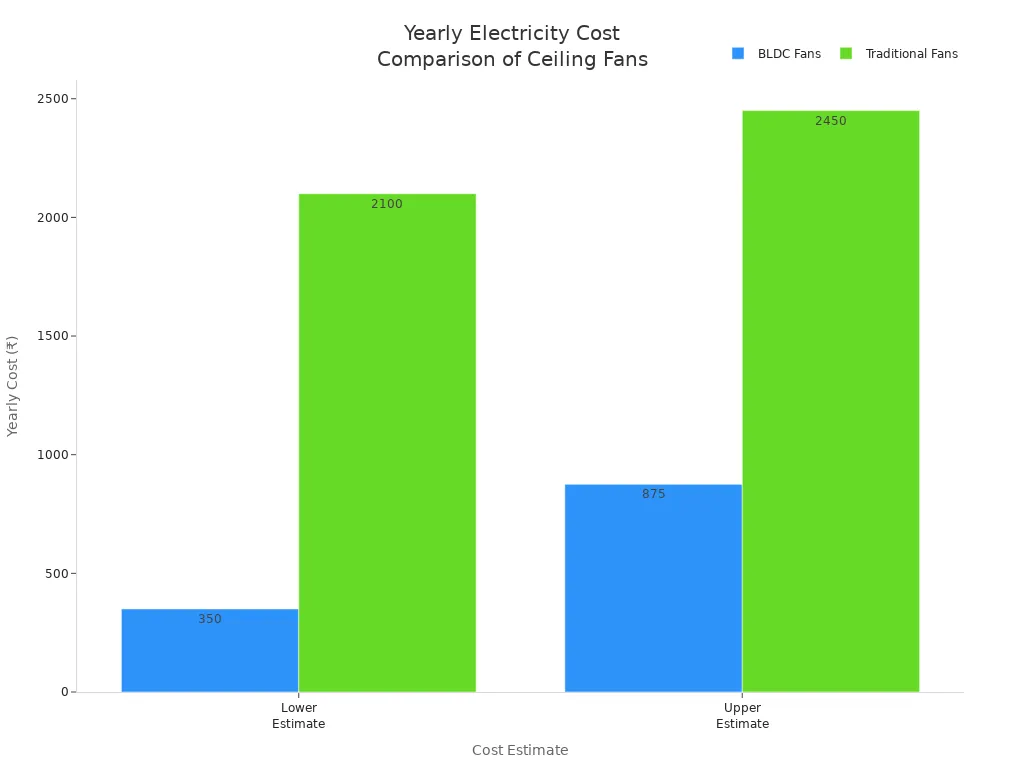
Tip: Switching to BLDC fans can help me save more than ₹1,500 every year on electricity bills.
Real-World Examples
I wanted to know if these savings happen in real homes and businesses. I found a study that compared three types of air handling units (AHUs). The results showed that BLDC motor-driven units used the least energy.
-
The conventional AHU used 12.4 kW at 34,702 m³/h.
-
The VFD motor used 9.4 kW at 34,935 m³/h.
-
The BLDC motor used only 8.4 kW at 34,702 m³/h.
The BLDC motor-driven AHUs were the most energy-efficient. The internal rate of return for the BLDC system reached about 60%. The carbon footprint for the BLDC fan was the lowest at 60.71 tons CO₂ per year. The conventional system produced 41.13 tons CO₂ per year.
I learned that Brushless DC (BLDC) ceiling fans not only save money but also help reduce carbon emissions. Many homeowners and businesses have switched to BLDC fans and noticed lower bills and quieter operation. I feel confident that making this change will benefit my home and the environment.
Cost Savings
Electricity Bill Impact
I noticed a big difference in my electricity bill after switching to BLDC ceiling fans. In the summer, my fans run almost all day. I want to keep my home cool without spending too much. Here is what I learned about how the type of ceiling fan affects my monthly bill:
-
Energy-efficient ceiling fans, especially those with DC motors, help me save a lot of money in hot weather.
-
Ceiling fans cost less than a cent per hour to run. Air conditioning can cost over 30 times more for the same time.
-
When I use ceiling fans with my air conditioner, I can set the thermostat higher. This trick helps me save even more on energy costs.
-
Using fans wisely makes my HVAC system work better. I get the same comfort but use less energy.
Tip: I always turn on my ceiling fan first before using the air conditioner. This way, I stay cool and keep my bills low.
Long-Term Value
I want to make smart choices that save me money over time. When I compared BLDC ceiling fans to traditional fans, I saw clear differences in cost, maintenance, and savings. Here is a table that helped me decide:
|
Factor |
BLDC Ceiling Fans |
Traditional Ceiling Fans |
|---|---|---|
|
Energy Efficiency |
Higher power consumption |
|
|
Lifespan and Maintenance |
Longer lifespan, less maintenance |
Brushes wear out, more maintenance |
|
Initial Cost |
Generally higher initial cost |
Usually cheaper to buy |
|
Long-term Savings |
Saves money on electricity and maintenance |
Higher long-term costs due to energy use and maintenance |
I realized that BLDC fans cost more at first, but I save money every month on my electricity bill. These fans last longer and need less fixing. Over the years, the savings add up. I feel good knowing I made a choice that helps my wallet and the environment.
Performance Factors
Airflow and Comfort
When I choose a ceiling fan, I always look for strong airflow. I want my room to feel cool and comfortable, especially during hot days. BLDC ceiling fans impress me with their powerful air delivery. These fans use advanced motors that push air evenly across the room. I notice that the breeze feels steady and refreshing, even when I set the fan at a lower speed.
Traditional ceiling fans also move air well. They have larger blades and can cover big spaces. Sometimes, I feel the airflow is not as consistent. The speed settings on older fans do not always give me the exact comfort I want. BLDC fans let me adjust the speed more precisely. I can pick the perfect setting for my needs.
Here is a quick comparison of airflow features:
|
Feature |
BLDC Ceiling Fans |
Traditional Ceiling Fans |
|---|---|---|
|
Air Delivery |
Steady, even breeze |
Strong, less consistent |
|
Speed Control |
Precise, many levels |
Basic, fewer options |
|
Comfort Experience |
Customizable |
Standard |
Tip: I always set my BLDC fan to a lower speed at night. I sleep better with gentle airflow.
Noise Levels
Noise matters to me when I relax or sleep. I want my fan to run quietly. BLDC ceiling fans stand out because they operate at 30–40 decibels. This level sounds like a soft whisper. I barely notice the fan running, even at high speed.
Traditional fans make more noise. They usually run at 50–60 decibels. I hear a humming sound from the motor and moving parts. Sometimes, the noise distracts me when I read or watch TV.
I learned that BLDC fans stay quiet because of their smooth design. They do not have brushes or extra friction. Traditional fans use mechanical parts and electromagnetic fields, which create more sound.
-
BLDC fans run quietly, producing gentle airflow.
-
Traditional fans make more noise due to mechanical parts.
I always choose BLDC fans for bedrooms and study areas. Quiet fans help me focus and sleep better. The difference in noise levels makes a big impact on my comfort at home.
Durability and Maintenance
Motor Lifespan
When I choose a ceiling fan, I want it to last for many years. I learned that BLDC ceiling fans have motors that run much longer than traditional fans. The brushless design means fewer parts wear out. I found that a well-designed BLDC motor can last anywhere from 20,000 to over 50,000 hours of continuous use. Some high-quality models even reach up to 50,000 hours if I use them in the best conditions. Traditional fans use brushed motors, which do not last as long. The brushes inside these motors wear down over time. This means I might need to replace or repair the motor sooner.
Here is a quick comparison of motor lifespans:
|
Fan Type |
Average Motor Lifespan |
|---|---|
|
BLDC Ceiling Fan |
20,000–50,000 hours |
|
Traditional Fan |
5,000–30,000 hours |
I feel confident choosing BLDC fans because I know they will keep working for many years. I do not worry about the motor wearing out quickly.
Maintenance Needs
I always look for appliances that do not need much maintenance. BLDC ceiling fans make my life easier because they have fewer moving parts. The brushless design means less wear and tear. I do not have to worry about replacing brushes or fixing mechanical problems. Over five years, I noticed that BLDC fans require very little attention. I save money because I do not pay for frequent repairs.
Here are some reasons why BLDC fans need less maintenance:
-
The brushless motor reduces wear and tear.
-
Fewer mechanical parts mean fewer breakdowns.
-
I spend less on repairs and upkeep.
Traditional ceiling fans need more care. The brushes and other parts wear out faster. I often have to clean, oil, or replace parts. Over time, these repairs add up. BLDC fans offer energy efficiency and convenience. I enjoy the peace of mind knowing my fan will run smoothly with minimal effort.
Tip: I clean the blades of my BLDC fan every few months to keep airflow strong. I do not worry about the motor or internal parts.
Smart Features
Remote and Automation
BLDC ceiling fans have smart remotes and automation. I can change the speed or turn the fan on and off. I do this without getting up from my seat. The remote works anywhere in the room. I do not need to point it at the fan. RF signals go through walls and furniture. I can control the fan from another part of the house.
Modern BLDC fans have intelligent modes. I use sleep mode at night for gentle airflow. Breeze mode helps keep the room cool during the day. Timer settings turn the fan off after a set time. These features help me save energy and stay comfortable.
Smart controls help everyone in my family. My grandparents use the remote easily. My kids change the fan speed from their beds. I control many fans with one remote. This saves time and effort.
Here are ways remote and automation features help me:
-
I control the fan from anywhere in the room.
-
RF technology works through walls and doors.
-
Modes like sleep, breeze, and timer add comfort.
-
My family uses the remote easily.
-
I control more than one fan with one device.
Smart Home Integration
BLDC ceiling fans work well with my smart home. I connect my fans to Alexa and Google Assistant. I use my voice to turn the fan on or off. I can also change the speed. I use an app on my phone to control the fan. I can do this even when I am not at home.
Traditional ceiling fans do not have these smart features. They need a wall switch and cannot connect to smart home systems. BLDC fans are different because they work with smart devices.
Here is a table that shows the difference in smart features:
|
Feature |
BLDC Ceiling Fans |
Traditional Ceiling Fans |
|---|---|---|
|
Smart Home Integration |
Yes, works with Alexa and Google Assistant |
No |
|
LED Lighting |
Yes, energy-saving and adjustable |
Usually no LED integration |
|
Remote Control |
Yes, easy to use |
Needs a wall switch |
|
Advanced Speed Control |
Yes, runs quietly |
Often noisy with basic speed control |
I like controlling my fan with my voice or phone. BLDC ceiling fans make my home smarter and more comfortable. I am glad I picked them for my family and my lifestyle.
Is Switching Worth It?
Upfront vs. Long-Term Savings
When I first looked at BLDC ceiling fans, I noticed the price was higher than regular fans. I paid two or three times more for a BLDC fan. I wondered if the savings would make up for the cost. After using my BLDC fan, I saw my electricity bill drop every month. BLDC fans use up to 65% less power than traditional fans. My utility bills became much lower, especially in summer.
I checked how long it would take to recover the extra money I spent. The payback period for BLDC ceiling fans is much shorter than I expected.
|
Fan Type |
Payback Period |
|---|---|
|
BLDC Ceiling Fans |
9.6 months |
|
Traditional Energy-Saving Fans |
13.7 months |
I realized that after less than a year, I started saving real money. BLDC fans also come with star labeling, which helps me see how much energy I save. Countries like China and those in the European Union now use similar labels. These rules make it easier for me to choose energy-efficient fans.
Some families find the upfront cost hard to manage. The higher price can be a barrier for low and middle-income households. Even so, the long-term savings make BLDC fans a smart choice for homes where fans run for many hours each day.
Tip: I always check the star rating before buying a fan. Higher ratings mean more savings over time.
Home and Office Suitability
I wanted to know if BLDC fans work well in both homes and offices. I learned that several factors matter when choosing the right fan:
-
Room size
-
Ceiling height
-
Motor technology
-
Energy efficiency
-
Smart features
-
Noise levels
-
Design preferences
-
Quality and effectiveness of air delivery
In my home, I need quiet fans with strong airflow. BLDC fans give me both. I can control the speed and use smart features like timers. In my office, I want fans that save energy and run smoothly all day. BLDC fans fit these needs because they use less power and stay quiet.
I always look at the room size and ceiling height before installing a fan. BLDC fans work well in large and small spaces. They deliver air evenly and keep everyone comfortable. I feel confident using BLDC fans in any room, whether at home or at work.
Note: BLDC fans offer smart controls and energy savings, making them suitable for modern homes and busy offices.
I learned that BLDC ceiling fans use less electricity than traditional fans. My electricity bills went down after I changed my fans. BLDC fans are quiet and last a long time. I think BLDC fans are a good choice for saving money and staying comfortable. Energy experts want people to know more about these fans and get help to buy them. Here is what they suggest:
|
Recommendation Type |
Details |
|---|---|
|
Financial Incentives |
Programs make energy-efficient appliances cheaper to buy. |
|
Consumer Awareness |
Knowing about BLDC fans makes more people want them. |
|
Quality Standards |
New labels show how efficient modern fans really are. |
|
Distribution Challenges |
Making fans easier to find helps more people get them. |
I always look at the labels and ask about deals before I buy a new fan.
FAQ
How much money can I save by switching to BLDC ceiling fans?
I save up to 60% on my electricity bill each month after switching to BLDC fans. For my home, this means I keep about ₹1,500 to ₹2,000 more every year. The savings add up quickly.
Are BLDC ceiling fans hard to install?
I found that installing a BLDC ceiling fan is just like installing a regular fan. I followed the instructions in the box. Most electricians know how to set them up. I did not need any special tools.
Do BLDC fans work with inverters during power cuts?
Yes, my BLDC fans run longer on inverters during power cuts. They use less power, so my backup lasts much longer. I noticed my fan keeps spinning even when other appliances stop.
Can I use a remote to control my BLDC ceiling fan?
I use a remote to change the speed, turn the fan on or off, and set timers. The remote works from anywhere in my room. This makes it easy for my family to stay comfortable.
Do BLDC ceiling fans need a lot of maintenance?
I spend less time on maintenance with my BLDC fans. The brushless motor means fewer parts wear out. I just clean the blades every few months. I do not worry about repairs.
